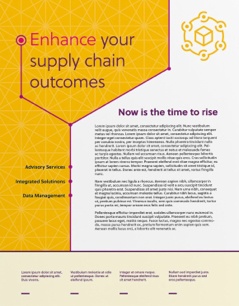"Meaningful innovation does not need to be based on outright invention. Rather, there is an exhilarating shortcut. It is based on bold, new combinations of already existing components that simultaneously unlock heightened levels of consumer value and reduce costs.” ~Gabor George Burt
The days of half-baked sourcing events are over. The days of poor planning in supply chain are over. The days of getting the sourcing event out the door with little effort, are just flat out over.
Not only are we asked to do more than we can possibly handle, but we are also asked to achieve world class savings on categories that have been sourced over and over again – and with limited resources. Yeah, the supply chain professional’s job just got real. And what I mean by real is real difficult.
Adding fuel to the already difficult situations, suppliers in the supply chain have gotten smarter. What we used to be able to get away with as supply chain professionals is now being leveraged by experienced suppliers. We must be more astute, work faster, be more efficient, and raise the bar on the status quo.
But there’s help on the horizon. Not only are supply chain software companies starting to get it, but the entire sourcing community is slowly stepping onboard too. We still must work harder, but the tools available these days make doing our job much more efficient. The time has never been so ripe for supply chain disruption!
Online sourcing tools have made the supply chain professional’s job significantly better than in the past. However, that is only if you let the tools do the work. Often, I see companies using the sourcing tool just to collect data. Then they export all that data into a big database and start the number crunching. Well, if you use that approach, you are missing out on the pure beauty and efficiency of the tool. If you use the tool to only collect supplier responses, you are utilizing only about 20% of your tool’s potential.
There are three easy strategies that affect the success of the RFP but are often overlooked.
Smarter, not longer
There is a direct correlation between the number of questions asked and the number of suppliers that disengage. The last thing you want to do is have suppliers disengage before they even review the RFP. Your goal is to keep as many suppliers involved for as long as you can.
When I am working with my clients over the past decade and even longer, there is a regular theme. I see really large RFPs with tons of questions, attachments and requirements. It is common to see 200+ questions in the RFPs but more importantly, supplier disengagement.
I am a believer that you always want every supplier that is invited to submit a bid. That is simply not the case with most of my clients. I can speculate that there is more than one reason this occurs. Some of the issues could be related to poor communication before and during the event, overwhelming the suppliers with more than they can realistically respond to, or even poorly executed RFPs.
One common issue I see is the RFPs being created today are just regurgitated content from previous RFPs the organization has run. As a result, the old content is reused and then added to over and over each time the category is sourced. This makes for an ugly and not very effective RFP.
I remember a conversation I had with two national account managers for separate manufactures that had responded to RFPs I had designed and delivered. I asked them what they thought of the RFPs. They each said the RFPs I ran were the most efficient RFPs they had ever seen. They went on to say that usually RFPs have to be sent to 4-5 separate departments for review to get their official response. For mine though, they told me they could respond to the entire RFP on their own with little to no feedback from others.
I then asked them the most important question: “Did I receive additional value due to the design of the RFP?” They each emphatically said “Absolutely yes!” A good part of their jobs is responding to and coordinating responses to RFP. In fact, they said that their companies receive at least one RFP per day – all year long.
For the record, these RFPs I sent out had 35-37 questions and contained a market basket of 50-100 items. That was significantly smaller than anything those manufacturers had ever received. The price savings received from those manufacturers were unheard of at the time.
The key is to make your RFPs smarter, not longer. How do I make them smarter? The key lies in the questions you ask or don’t ask.
Questions Without a Doubt
One of the most effective ways to be disruptive in the supply chain is to ask better questions. You want to get a very clear understanding of what the supplier can and cannot do. If you ask a useless question, chances are that you will get less than desirable responses.
When you are writing questions for the RFP, ask questions that will differentiate the suppliers. For example, a standard question I see on a lot of RFPs is, “What is your disaster relief policy?” The suppliers can then go to their website and pull down the standard policy. It may seem like a decent question until you see it in best practice form.
The disaster relief question best practice looks something like this, “Please describe your disaster relief policy by specifically detailing how your company supplied products and services across the US at the onset of the Covid pandemic in early March 2020.” I guarantee that you will get a much different response than asking the standard open-ended question.
With a little practice, you can be an expert. Look at every single question and identify how you can make it better to allow you to create more supplier differentiation. But, it doesn’t stop there. Properly scoring your RFPs is critical and represents serious efficiencies gained.
Score and Award
To score or not to score, that is the question but that question has to be scored. To be disruptive in the supply chain, you absolutely must utilize your online sourcing tool’s full potential. If you lack the technology, go out and get it. A single event can easily pay for the entire years’ subscription! Research has proven that just publishing an event using eSourcing will net you on average 7-9%. And that isn’t even taken into account making utilizing RFP best practices!
To maximize the software, let the system score your RFP. I can tell you it isn’t as easy as just throwing questions out there and letting the tool spit out the scoring results. A lot of thought has to go into the process.
When you build the questions, design them to get maximum results. I like to use the 80/20 rule where you have 80% of the questions set to autoscore, while the remaining 20% are used to differentiate. Examples of autoscored questions are multiple choice/single answer, multiple choice/multiple answer, yes/no, numerical, etc. Questions that differentiate between respondents tend to be free text or attachments.
One other item to take note of is to limit using yes/no questions to score. You can use them to qualify the suppliers upfront, but I rarely use them in the scoring process. When you ask lots of yes/no questions, the ability to separate or differentiate suppliers from one another is significantly compromised.
If you would like to disrupt your sourcing, I suggest looking into our RFP Template Best Practice Writing Course. In only six weeks, we will teach you 1) How to write best practice questions, 2) How to build best practice market baskets, 3) How to do proper research and become a subject matter expert in 4-8 hours; 4) Provide you RFP tips and tricks that are backed by research and practice; 5) Design a RFP Template Blueprint; and finally, 6) Present your best practice RFP template in front of the class.
When you use these strategies, you are certain to get better results with your RFPs. Better RFPs equate into increased savings, value from suppliers as well as efficiencies at your organization. Remember the golden rule is to keep your RFPs simple while instilling more depth to clearly differentiate the suppliers.






Comments